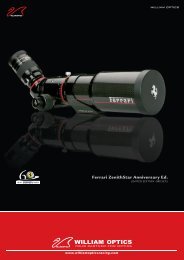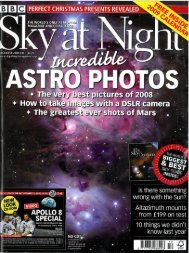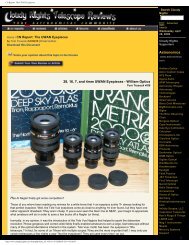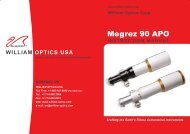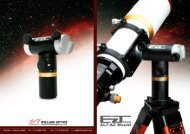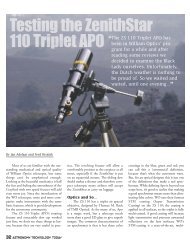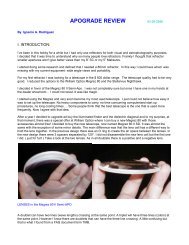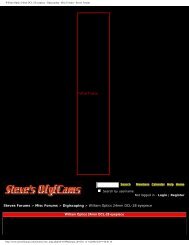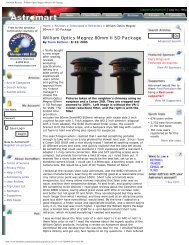Megrez Fluorite Doublet vs M80 ED by Fred Hissink ... - William Optics
Megrez Fluorite Doublet vs M80 ED by Fred Hissink ... - William Optics
Megrez Fluorite Doublet vs M80 ED by Fred Hissink ... - William Optics
You also want an ePaper? Increase the reach of your titles
YUMPU automatically turns print PDFs into web optimized ePapers that Google loves.
showed the same details; we saw sharpand black shadows running across themoon’s surface, craters with very finestructures and as mentioned above,topographic details in the ashen light.But, the <strong>Megrez</strong> Fl. gave the impressionof providing a slightly sharper andbrighter image. Not much, but justenough to be noticed.After two hours of testing, seeing conditionsimproved and the differences betweenthe scopes were less pronounced.This indicates that when the quality ofseeing increases, the difference betweenboth scopes becomes smaller; this meansthat the apochromatic performance andthe sharpness/freshness of the image arenearly the same in both scopes whenthere is almost no atmospheric turbulence.APO performance?Talking about apochromatic performance,let us get to the point: there is no sign offalse color in either scope at low magnification.As we increased the magnification,the <strong>Megrez</strong> <strong>ED</strong> continued to give us colorfreeimages, but the <strong>Megrez</strong> Fl. didn’t followthe footsteps of his twin brother. Infact, the <strong>Megrez</strong> Fl. showed a slightly redrim around bright stars and a red hazearound the edge of the moon. Again, thedifference was not much, but noticeable.High powersBoth scopes are unafraid of high powers;at the end of our session we took someVixen Lanthanum (LV) eyepieces andused so-called ‘empty magnifications’.But, empty or not, both scopes swallowed300 times without any problem! At thismagnification, the image of the moon wasstill very pleasant! The images of Saturnconfirmed the quality of the seeing, asmentioned above.Both scopes provided wonderful views;the Cassini Division was clearly visible asa dark line and the color difference betweenthe A and B ring was obvious.Subtle details were visible on the equatorialbelt and on this evening high magnificationscould be used. The <strong>Megrez</strong> Fl.showed a somewhat crisper image atmoderate seeing, but at moments of goodto very good conditions the <strong>Megrez</strong> <strong>ED</strong>gave us identical views. There was no redfringing around Saturn when viewedthrough the <strong>Megrez</strong> Fl., but this mighthave been because it was relatively dimcompared to the moon.DeepskyAfter the moon had disappeared we trieda few deepsky-objects. M3 in Canes Venaticiwas a beautiful target and showeda faint mottling at the edges, as if wewere looking at a sugar pot. Sometimesindividual stars were popping into view.There were no differences in the viewsthrough either scopes; the light distributionon the surface of the globular clusterand the ‘white’ appearance were identicalin both scopes. We picked a few otherDSO’s that night, but with the same results.Who’s the winner?Well, both scopes are absolutely topnotch,so in fact they are both winners.But, there are subtle differences betweenthem: the <strong>Megrez</strong> <strong>ED</strong> has a better colorcorrection and is in fact totally free offalse color. The <strong>Megrez</strong> Fl. has a sharperand brighter image at higher magnifications;possibly because of the SuperTransmission Coating (STM) These differencesare more apparent under bad ormoderate seeing conditions. It is hard toseparate the images of both scopes whenthe seeing is good or excellent (althoughwe ‘only’ had moments of good seeingduring our test)SummarySo, should you moan about the fact thatyour scope has a lens with fluoriteparticlesand not a ‘real’ fluorite element?Do you want to sell your scope because itis a doublet APO and not a triplet? Do youwant a <strong>Megrez</strong> <strong>Fluorite</strong> <strong>Doublet</strong> instead ofa <strong>Megrez</strong> <strong>ED</strong> triplet APO now you haveheard this story? No, we don’t think so…Bear in mind that both scopes are excellentperformers and the price-to-qualityratio is unbeatable! Enjoy the viewsthrough your triplet or doublet and remember:it is not only the telescope thatwill give you a satisfying night under thestars; but also the perseverance of theobserver that matters!




